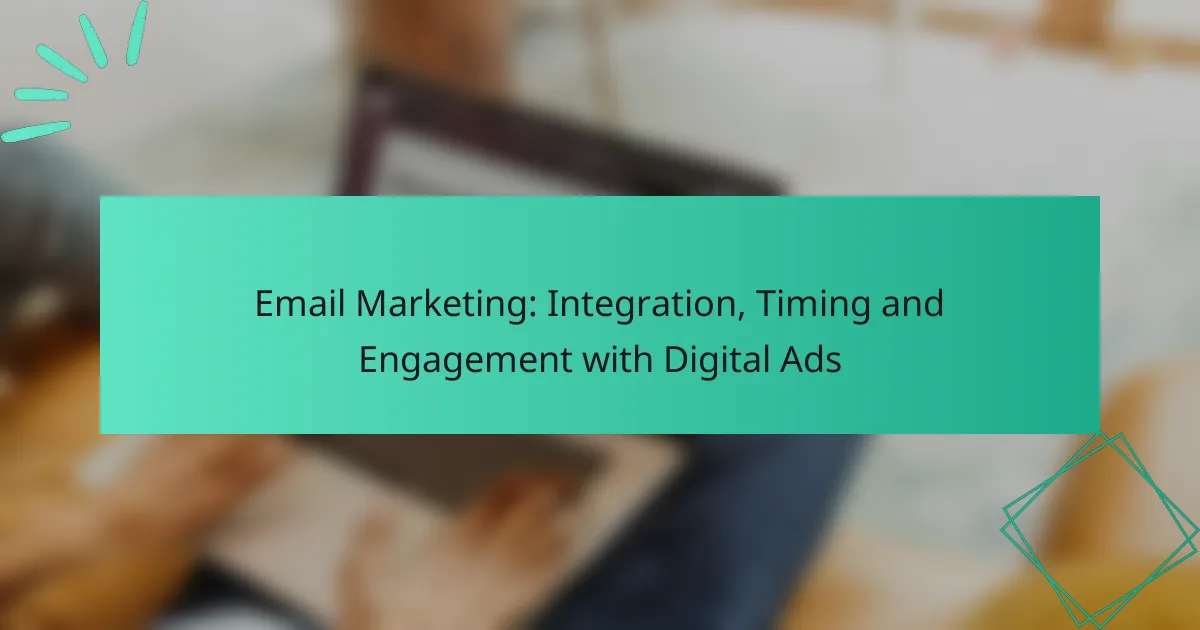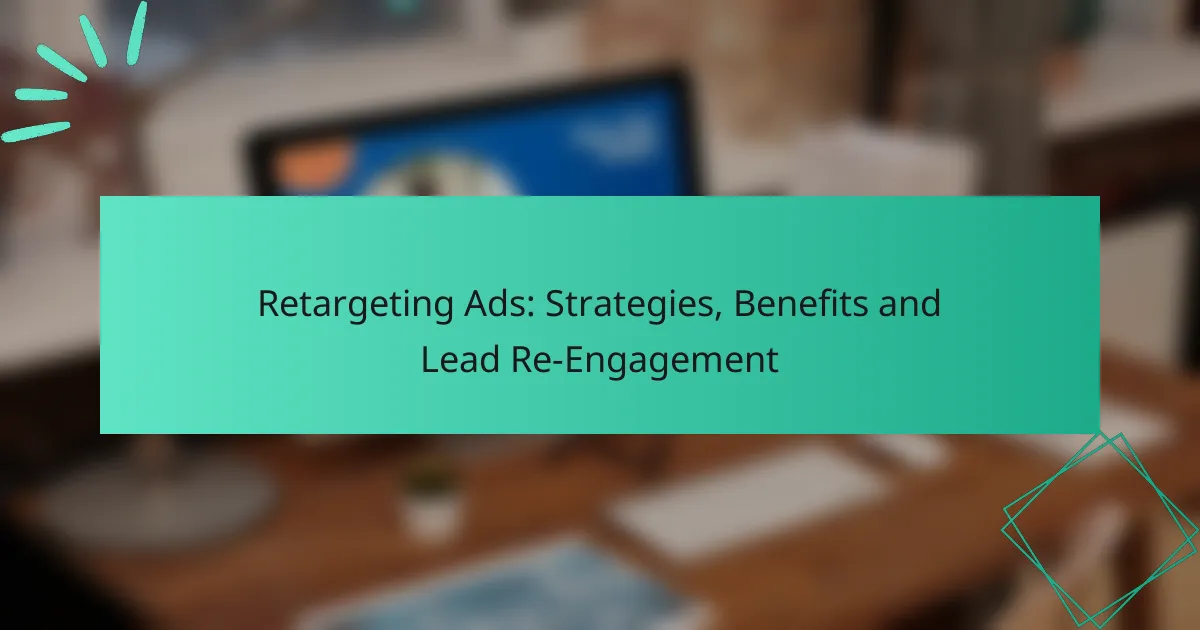Email marketing and digital ads can work hand in hand to boost engagement and conversion rates. By integrating these channels, marketers can create a unified strategy that resonates with audiences, particularly when considering the optimal timing for email campaigns. Personalizing content and strategically aligning messages enhances the overall effectiveness of both mediums, leading to improved response rates.

How to integrate email marketing with digital ads in Canada?
Integrating email marketing with digital ads in Canada involves using both channels to complement each other, enhancing overall engagement and conversion rates. By strategically aligning your email campaigns with digital advertisements, you can create a cohesive marketing strategy that maximizes reach and effectiveness.
Email platforms like Mailchimp and HubSpot
Email platforms such as Mailchimp and HubSpot offer tools to seamlessly integrate your email marketing efforts with digital advertising. These platforms allow you to create targeted email campaigns that can be promoted through ads, ensuring that your messaging is consistent across channels.
For example, you can use Mailchimp’s audience segmentation features to tailor your email content based on user behavior, then retarget those same users with ads on social media or Google. This approach not only reinforces your message but also increases the likelihood of conversions.
Advertising networks such as Google Ads and Facebook Ads
Advertising networks like Google Ads and Facebook Ads provide opportunities to reach your audience effectively while complementing your email marketing. By utilizing these platforms, you can create ads that promote specific email campaigns, encouraging recipients to take action.
Consider using Facebook Ads to promote a special offer that you have sent out via email. This can help capture the attention of users who may have missed the email or need an additional nudge to engage. Always monitor the performance of your ads in conjunction with your email metrics to optimize your strategy over time.

What is the best timing for email marketing campaigns?
The best timing for email marketing campaigns depends on your audience’s behavior and preferences. Generally, sending emails during weekdays, particularly mid-morning or early afternoon, tends to yield higher engagement rates.
Optimal send times based on audience behavior
Understanding your audience’s behavior is crucial for timing your email campaigns effectively. Research indicates that emails sent on Tuesdays and Thursdays often see better open rates compared to other days. Additionally, consider segmenting your audience by time zones to ensure emails arrive at optimal times for each group.
Testing different send times can provide valuable insights. For instance, try sending emails at various times throughout the week and analyze the open and click-through rates to identify patterns specific to your audience.
Seasonal trends affecting engagement
Seasonal trends can significantly impact email engagement. For example, during the holiday season, consumers are more receptive to promotional emails, making it an ideal time to increase your campaign frequency. Conversely, summer months may see lower engagement as people take vacations.
To capitalize on seasonal trends, plan your campaigns around key holidays and events relevant to your audience. Use a calendar to map out these dates and prepare your content in advance to maximize engagement during peak times.

How to enhance engagement through email and ads?
Enhancing engagement through email and ads involves integrating personalized content and strategic timing to capture audience attention. By aligning your email marketing efforts with digital advertising, you can create a cohesive experience that encourages higher response rates and conversions.
Personalization techniques for higher open rates
Personalization is key to increasing email open rates. Techniques such as using the recipient’s name in the subject line or tailoring content based on previous interactions can significantly enhance engagement. For instance, segmenting your email list by demographics or purchase history allows for more relevant messaging.
Consider implementing dynamic content that changes based on user behavior. This could include product recommendations or special offers that reflect past purchases. Personalized emails can yield open rates that are tens of percent higher than generic messages.
Using retargeting ads to boost email responses
Retargeting ads serve as a powerful tool to remind users about your emails and encourage them to take action. When a recipient opens an email but does not engage further, retargeting ads can display relevant offers on social media or other websites they visit, reinforcing your message and prompting a response.
To effectively use retargeting, ensure your ads are aligned with the content of your emails. For example, if you sent a promotional email about a specific product, your retargeting ads should feature that product or similar items. This consistency can improve conversion rates and keep your brand top-of-mind.

What are the prerequisites for effective email and ad integration?
Effective integration of email marketing and digital ads requires a clear understanding of customer behavior and strategic planning. Key prerequisites include customer segmentation and well-defined campaign goals to ensure that messaging resonates with the target audience.
Understanding customer segmentation
Customer segmentation involves dividing your audience into distinct groups based on shared characteristics such as demographics, interests, or purchasing behavior. This allows for tailored messaging that speaks directly to each segment’s needs, increasing engagement and conversion rates.
To implement effective segmentation, consider using data analytics tools to gather insights from previous campaigns. For instance, segmenting by age group or purchase history can help you craft personalized email content that complements your digital ads, leading to a more cohesive marketing strategy.
Setting clear campaign goals
Setting clear campaign goals is crucial for measuring the success of your email and ad integration efforts. Goals should be specific, measurable, achievable, relevant, and time-bound (SMART). For example, aim to increase email open rates by a certain percentage or drive a specific number of conversions from your ads.
When defining your goals, consider aligning them with your overall marketing objectives. This could involve increasing brand awareness, boosting sales, or enhancing customer retention. Regularly review these goals to adapt to changing market conditions and audience preferences.

How to measure the success of email and ad campaigns?
Measuring the success of email and ad campaigns involves analyzing various performance metrics to determine their effectiveness. Key indicators include open rates, click-through rates, conversion rates, and return on investment (ROI), which help assess engagement and overall impact.
Key performance indicators for email marketing
Key performance indicators (KPIs) for email marketing include open rates, click-through rates (CTR), conversion rates, and unsubscribe rates. Open rates indicate how many recipients opened the email, while CTR measures the percentage of those who clicked on links within the email. A good open rate typically ranges from 15% to 25%, while a CTR of 2% to 5% is often considered effective.
Additionally, tracking conversion rates helps determine how many recipients took the desired action, such as making a purchase or signing up for a newsletter. Monitoring unsubscribe rates can also provide insights into audience engagement and content relevance, with a rate below 0.5% generally being acceptable.
Tracking ad performance metrics
Tracking ad performance metrics is crucial for evaluating the effectiveness of digital advertising campaigns. Key metrics include impressions, clicks, click-through rates, and conversion rates. Impressions indicate how often an ad is displayed, while clicks show how many users interacted with the ad. A CTR of 1% to 3% is commonly seen as a good benchmark for online ads.
Conversion rates measure the percentage of users who completed a desired action after clicking the ad, such as making a purchase. Effective tracking tools like Google Analytics can help marketers analyze these metrics and optimize their campaigns accordingly. Regularly reviewing these metrics allows for timely adjustments to improve overall campaign performance.

What are the emerging trends in email marketing and digital ads?
Emerging trends in email marketing and digital ads focus on enhancing user engagement through advanced technologies and interactive elements. Marketers are increasingly leveraging AI and interactive content to create personalized experiences that resonate with their audience.
AI-driven personalization in campaigns
AI-driven personalization tailors email content based on user behavior, preferences, and demographics. By analyzing data, marketers can send targeted messages that significantly improve open and click-through rates.
For example, using AI algorithms, brands can segment their audience into distinct groups and craft messages that speak directly to each segment’s interests. This approach can lead to higher engagement and conversion rates, often exceeding traditional methods by a notable margin.
Integration of interactive content in emails
Integrating interactive content, such as polls, quizzes, and videos, transforms static emails into engaging experiences. This trend encourages recipients to interact with the content, leading to increased time spent on emails and improved brand recall.
Marketers should consider using tools that allow for easy embedding of interactive elements. Simple techniques like including a quick survey or a clickable image carousel can enhance user engagement and provide valuable feedback for future campaigns.



